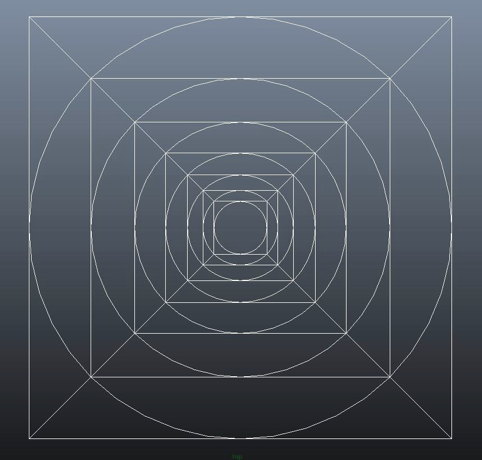Hello there Gamedev.net
This is about rendering a realistic perspective viewport. I know that matrices and trigonometry are used, from my days doing maths at school, but i’ve never seen the code for DirectX or OpenGL. I have some ideas about how software engineers might do it but I need more information.
First thing I should mention is this geometry, where a square bounds and circle, then a bigger circle bounds that square, and you keep repeating it as shown in the diagram below. If you draw diagonal lines, from the centre, to the corners of the geometry, it looks like you could walk through it, like a realistic corridor. I’m calling each square/circle pair a unit of depth (in to, out of) the scene. If you add a bigger square/circle to the outside, this pushes the far clipping plane further away from the virtual camera.

How is this idea useful for building a code based engine for allowing transformations (move, rotate, scale) to occur? I think if you consider the length from the origin, up to the point at which the next square intersects the circle, and store this value, to build a series, you could use the expression to apply transformations in an efficient way.
I have started working on a table that builds the expression from the bottom up, here is what I have so far.
n (units of depth out of the scene)
y (square/circle intersection)
√ (2*(circle minus square)2)
expression for y
6
22.14213562373095
9.65685424949238
4+√8+√32+(4+√32)
5
12.48528137423857
5.65685424949238
4+√8+√32
4
6.82842712474619
2.82842712474619
4+√8
3
4
2
4
2
2
0.585786437626905
2
1
1.414213562373095
0.414213562373095
√2
I do it from the bottom up, because the geometry starts in the centre and works outwards. I start with a square who’s length from the origin to the edge is 1, and to calculate the length from the origin to the corner, from pythagorean trig, is √(2*(12)), namely, (two times 1 squared, square rooted), or √2. Then, by subtracting 1 from root 2 (to give you the difference between the square/circle pair), and using the same function, to calculate the length from the corner, to the next corner (outwards), you can add this value onto the value from the previous iteration, to give a new value for the next term in the expression.
Building the expressions up in this way, and having an expression for y, should hopefully help us to figure out an expression for the entire series. I am thinking that this has already been done, by the guys at Microsoft and Silicon Graphics (DirectX, OpenGL), but I need more information because this seems like the most interesting part of computer graphics.
So I guess my question is, can you point me to further resources, or help me find more information about this technique. I was hoping there would be a wikipedia page showing how the technique works, it’s just that I don’t know what it’s called. It seems quadratic to me, but I would love to read about it, and see the code.
I tried to get in touch with Jim Van Verth too, but he hasn’t replied to me yet. Jim worked for Nvidia so he might know exactly how they do it.
Best regards.
—
Steven Wiseman





